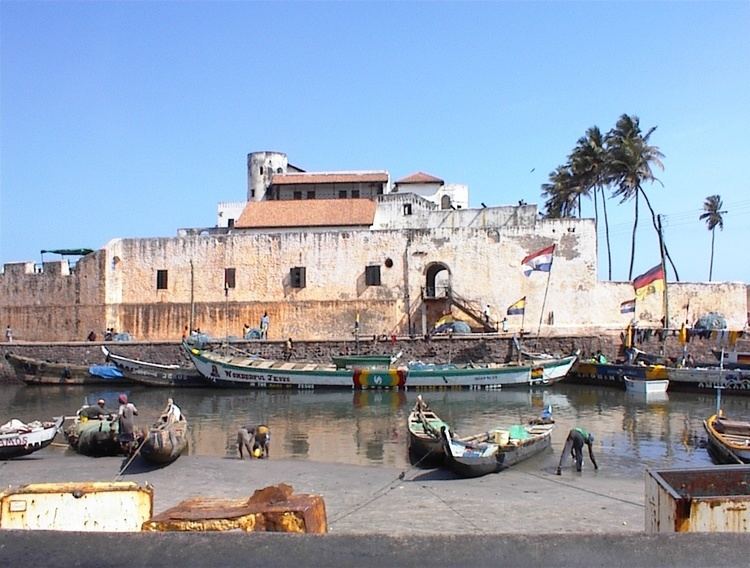Time zone GMT Local time Thursday 12:40 PM | Population 33,576 (2013) | |
 | ||
Weather 30°C, Wind SW at 19 km/h, 76% Humidity | ||
Elmina castle elmina ghana
Elmina is a town and the capital of the Komenda/Edina/Eguafo/Abirem District on the south coast of South Ghana in the Central Region, situated on a south-facing bay on the Atlantic Ocean coast of Ghana, 12 km (7.5 mi) west of Cape Coast. Elmina is the first European settlement in West Africa and it has a population of 33,576 people.
Contents
- Elmina castle elmina ghana
- Map of Elmina Ghana
- Getting to elmina ghana and the first views of elmina castle
- History
- Twenty first century
- Tourism
- Sister cities
- References
Map of Elmina, Ghana
Getting to elmina ghana and the first views of elmina castle
History
Prior to the arrival of the Portuguese, the town was called Anomansah (the perpetual drink). In 1478 (during the War of the Castilian Succession), near the coast at Elmina was fought a large battle between a Castilian armada of 35 caravels and a Portuguese fleet for hegemony of the Guinea trade (gold, slaves, ivory and melegueta pepper). The war ended with a Portuguese naval victory followed by the official recognition by the Catholic Monarchs of Portuguese sovereignty over most of the West African territories in dispute embodied in the Treaty of Alcáçovas,1479. This was the first colonial war among European powers. Many more would come.
The town grew around São Jorge da Mina Castle, built by the Portuguese Diogo de Azambuja in 1482 on the site of a town or village called Amankwakurom or Amankwa. It was Portugal's West African headquarters for trade and exploitation of African wealth. The original Portuguese interest was gold, with 8,000 ounces shipped to Lisbon from 1487 to 1489, 22,500 ounces from 1494 to 1496, and 26,000 ounces by the start of the sixteenth century.
Later the port expanded to include tens of thousands of slaves channeled through the trading post of Elmina, ten to twelve thousand from 1500-35 alone. By 1479, the Portuguese were transporting slaves from as far away as Benin, accounted for 10 percent of the trade in Elmina, and were used to clear land for tillage.
The location of Elmina made it a significant site for reprovisioning ships headed south towards the Cape of Good Hope on their way to India. After years of Portuguese wealth on the Elmina Coast, the Dutch learned of the profitable activity taking place through Barent Eriksz of Medenblick, one of the oldest traders and Guinea Navigators. Erickzen received information about trading on the Elmina coast while he was a prisoner on Principe and consequently was a major resource to the Dutch in terms of providing geographical and trading information. The Dutch West India Company captured it in 1637; in subsequent centuries it was mostly used for the slave trade. The British attacked the city in 1782, but it remained in Dutch hands until 1872, when the Dutch Gold Coast was sold to the British.
Elmina is also home to Fort Coenraadsburg on St. Jago Hill, built by the Portuguese in 1555 under the name Forte de Santiago, it was used for commerce. In 1637 it was conquered and remained by the Dutch, after the conquest of Elmina's main castle. Today, Elmina's main economic industry is fishing and tourism.
Twenty-first century
Beginning in 2003, Elmina, along with foreign investors, began The Elmina Strategy 2015, a massive project to improve many aspects of the town, consisting of water drainage and waste management helping to improve the health of the citizens, repairing the fishing industry and harbour of within Elmina, tourism and economic development, improved health services, and improved educational services.
Tourism
Apart from Elmina Castle and Fort Coenraadsburg, the main tourist attractions in Elmina include the Dutch Cemetery and the Elmina Java Museum.
Sister cities
List of sister cities of Elmina, designated by Sister Cities International:
